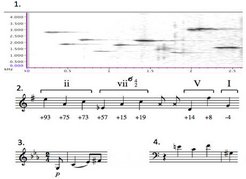I’m singing in the rainforest
Researchers find striking similarities between bird song and human music
The origin of human music has long been the subject of intense discussion between philosophers, cultural scientists and naturalists. Researchers from the Max Planck Institute for Ornithology in Seewiesen, Germany and Cornish College of the Arts in Seattle, US, have now found striking parallels between our music and the song of a small brown bird living in the Amazon region. The Musician Wren favors consonant over dissonant intervals, something that has rarely been observed in other animal species before. This bird’s musicality goes even further: it prefers to sing perfect consonances (octaves, perfect fifths, and perfect fourths) over imperfect consonances leading to some passages which may sound to human listeners as if they are structured around a tonal center.

The Musician Wren (Cyphorhynus arada) is aptly-named, because these birds use the same intervals in their songs that are heard as consonant in many human cultures. This is what composer and musicologist Emily Doolittle and the biologist Henrik Brumm found out in their zoomusicological study. Consonant intervals are perceived to fit well together. They sound calm and stable, and are the basis for keys in Western Music. It is because Musician Wrens preferentially produce successive perfect octaves, fifths, and fourths that their songs sound musical to human listeners.
In fact the researchers found passages in the songs of the Musician Wrens with striking similarity to passages of e.g. the composers Bach and Haydn. “However, this does not mean that the musician wren is singing in a key the way a human musician might. Rather, the bird’s preference for consonances leads to occasional conjunctions of pitches which sound to human listeners like they are drawn from the same scale”, says Emily Doolittle.
In 2011, Emily Doolittle was composer-in-residence at the Max Planck Institute for Ornithology in Seewiesen, Germany, where she collaborated with ornithologist Henrik Brumm in researching song of the musician wren, gathered birdsongs for future musical use, and presented a concert of her birdsong-related works, performed by members of the Bavarian State Opera.
The now published study reveals that the song of the “Uirapuru” (the Portuguese name for the Musician Wren) is often a part of Brazilian music. The composer Heitor Villa-Lobos wrote a symphonic poem in 1917 called “Uirapuru”. Other closely related birds did not receive such an honor: although they have pleasant songs, they lack the harmonic intervals of the musician wrens. Doolittle and Brumm tested 91 human listeners by asking them to compare successions of intervals taken from the musician wrens’ songs with computer-generated songs in which the contours and durations remained the same but the intervals were slightly altered. The results were clear: human listeners considered the birds’ interval choices to be more “musical”.
“Our findings explain why this bird species plays such a prominent role in mythology and art. However, it does not mean that birdsong in general is constructed like human music – there are around 4000 different song bird species and each has its own way of singing. Some are not very musical at all,” says Henrik Brumm, research group leader in Seewiesen.
It remains mysterious whether and how musician wrens perceive musical intervals and how they think about structuring their songs, though this would be an excellent subject for further study. The perception of intervals and other aspects of human music by non-human animals are of considerable relevance with regards to the origin of human music.
SSp/HR












